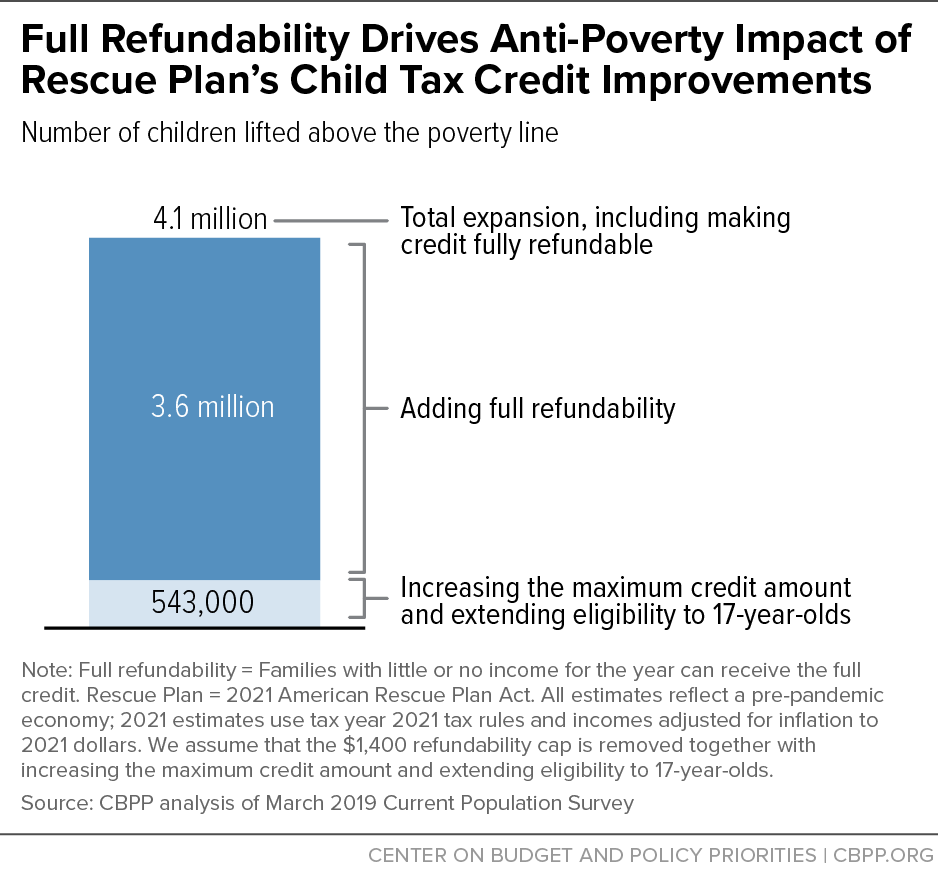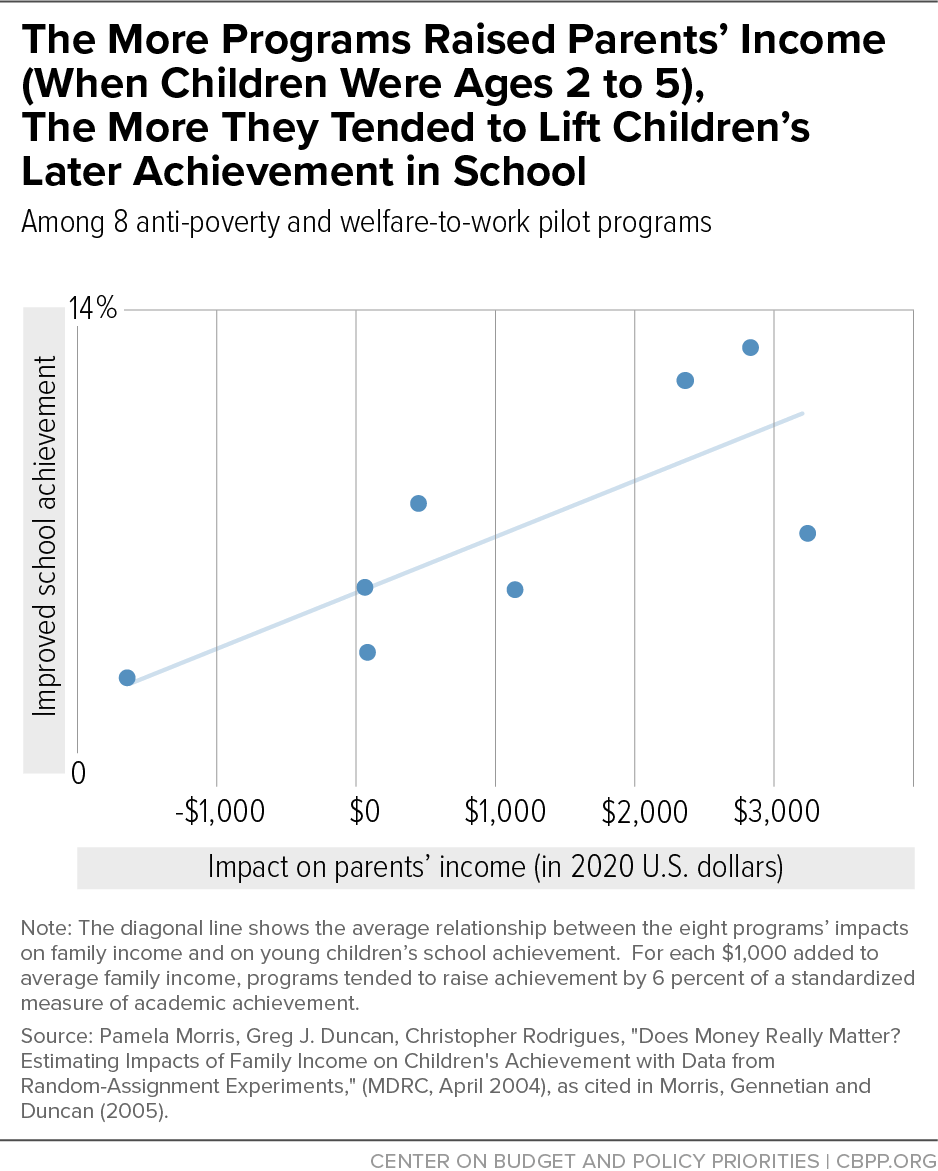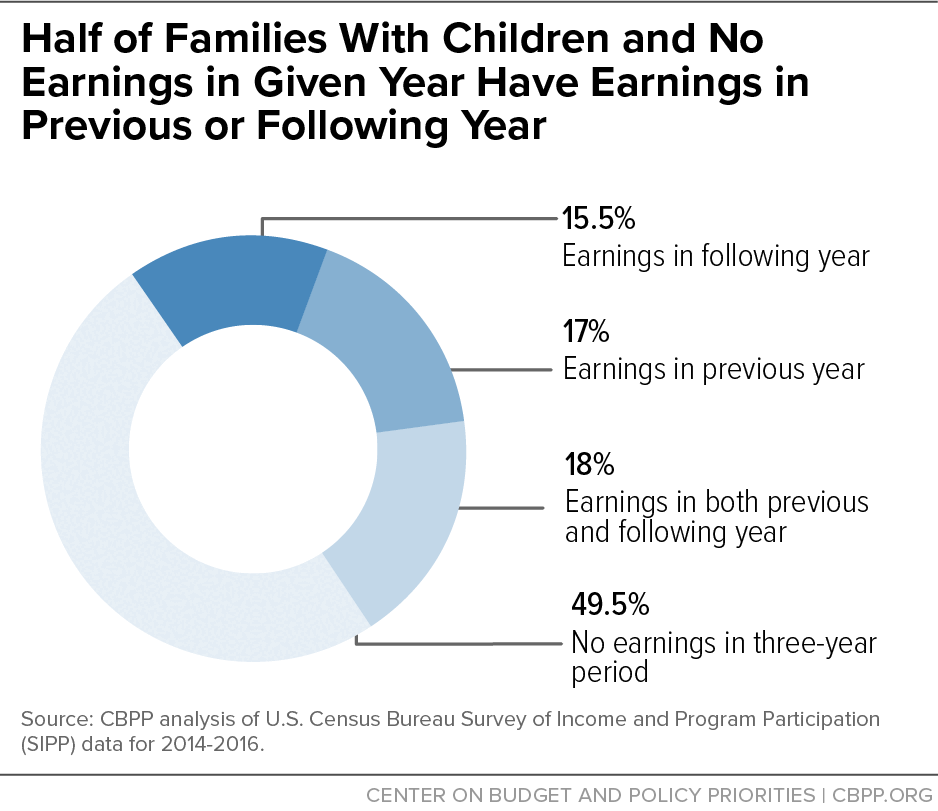The major economic recovery legislation Congress is now developing should make the full Child Tax Credit permanently available to children whose families have low earnings or lack earnings in a year. Prior to enactment of the American Rescue Plan in March, 27 million children received less than the full Child Tax Credit or no credit at all because their families’ incomes were too low, including roughly half of all Black and Latino children and children who live in rural communities.[1] This upside-down policy gave less help to the very children who needed it most. The Rescue Plan fixed this policy on a temporary basis, ensuring that in 2021, children in families with low incomes receive the same credit as children in higher-income families; the largest gains accrue to children of color, who were more likely not to receive the full credit prior to this policy. In the forthcoming recovery legislation, policymakers should finish the job by making this improvement permanent.
The Rescue Plan’s other Child Tax Credit provisions also should ultimately be made permanent; taken together, the Rescue Plan improvements will reduce the child poverty rate by more than 40 percent. The full availability provision is the main driver of this historic reduction, lifting 3.6 million children above the poverty line. The law’s other Child Tax Credit provisions — an increase in the maximum credit and extension of eligibility to 17-year-olds — lift the incomes of another 0.5 million children above the poverty line. In percentage terms, full availability is responsible for 87 percent of the provisions’ anti-poverty impact.
Early data show that parents with low and moderate incomes largely spent their initial Child Tax Credit payments on necessities, including food, utilities, clothing, and housing. The number of households that reported not having enough to eat dropped by 3.3 million or nearly one-third in the weeks after the IRS issued the first payment. Many families with low incomes received the full credit for the first time, which likely contributed to this sharp drop in food insecurity.
Making the full credit available on a permanent basis to children in families with low incomes would benefit the children themselves and society as a whole. For children, research indicates the added family income helps them do better and go further in school, earn more in adulthood, and have better health outcomes. Additional income also provides financial stability for families experiencing poverty and can reduce the significant stress that parents in these families often face, helping them better meet their families’ needs. The income also supplements families’ earnings when parents work in low-paid jobs. Many of the families of children who would benefit work hard at important but low-paid jobs; for example, making the Child Tax Credit fully available to families with low incomes would benefit 3 million working adults in occupations recognized as essential during the pandemic. (See Table 1 below.)
The fiscal cost of making the Child Tax Credit fully available on a permanent basis is modest. President Biden’s American Families Plan proposed extending the Rescue Plan’s complete Child Tax Credit expansion — which made the credit fully available, raised the maximum credit, and included 17-year-olds — through 2025 but making the full availability provision permanent. (After 2025, the maximum credit amount would return to $1,000 per child when the relevant provision of the 2017 tax law expires.) As Congress crafts Build Back Better legislation, policymakers will need to decide how long to extend the Rescue Plan’s Child Tax Credit expansion. If they cannot make the full expansion permanent because of cost constraints, at a minimum they should make the full credit available to children in families with the lowest incomes on a permanent basis. This would ensure that whatever the level of the credit in the future, the full amount will be available to both low- and middle-income children. If, as President Biden has proposed, the increase in the maximum credit is extended through 2025, then the additional cost of making the credit fully available on a permanent basis would be less than $3 billion per year over 2026-2031, according to Treasury Department estimates,[2] for a total cost of roughly $16 billion over that period.
All other similarly wealthy nations have a comparable policy (commonly called a “child allowance”) that financially assists most families, including those with the lowest incomes, to help them successfully raise their children.[3] Making the full Child Tax Credit permanently available for those with the lowest incomes would ensure children in the United States receive this same form of support.
Enacted in 1997, the original Child Tax Credit largely excluded children whose families had low or moderate incomes because the credit could only be used to offset a family’s income tax liability, not to boost a family’s low income. As evidence mounted over the following quarter-century about the importance of income to children’s growth and development, policymakers from both parties have worked to correct this flaw and expand the credit for families with low incomes.
As part of tax legislation President George W. Bush signed in 2001, a bipartisan group of senators restructured the Child Tax Credit to make it partially “refundable,” meaning that a family with little or no income tax liability could receive part of the credit as a refund. The refundable part of the credit was worth 15 percent of a household’s earnings over $10,000, with this threshold indexed for inflation. The legislation also doubled the maximum credit from $500 to $1,000 per child. For example, a single mother of two earning $15,000 per year received an annual credit equal to 15 percent of her earnings above $10,000, which amounted to $750 ($5,000 x 15 percent) or $375 per child. Without the 2001 legislation, this family would have received no credit at all. However, this family’s $750 credit was well below the $2,000 a middle-income family with two children would receive, and a family with two children and $10,000 in earnings or less continued to be completely shut out of the Child Tax Credit.
During each of the Bush, Obama, and Trump Administrations, policymakers on a bipartisan basis incrementally reduced the earnings threshold. Most recently, Republican Senators Marco Rubio and Mike Lee pushed to reduce it to $2,500 in the 2017 tax law, which also increased the maximum credit to $2,000 per child. But because the credit only phased in at the rate of 15 cents on the dollar for earnings above $2,500, a mother of two earning $15,000 received just $1,875 per year (or about $900 per child), still substantially less than middle-income families.
Thus, while these bipartisan steps over the years improved living standards for millions of families, 27 million children[4] received only a partial credit or no credit at all because their families earned too little or lacked earnings in a year. That included roughly half of all Black children and half of all Latino children, whose families (along with other families of color) are overrepresented in low-paid work and face worse employment prospects due to historical and ongoing discrimination in education, housing, employment, and criminal justice that has systematically limited opportunity.[5] This exclusion had highly disparate racial impacts as only about 20 percent of white children didn’t receive the full credit because their families’ incomes were too low.
The American Rescue Plan took a major step in rectifying this problem by making the full Child Tax Credit available to children in families with low or no earnings for 2021. Specifically, the law eliminated the $2,500 income threshold and the 15 percent phase-in to ensure that children in families with the lowest incomes receive the same Child Tax Credit as children in families with higher earnings. (The law also expanded the credit in other ways, described below.) President Biden has proposed making this improvement permanent as part of recovery legislation that Congress is now developing.
The Rescue Plan’s one-year expansion of the Child Tax Credit will result in historic progress against child poverty, reducing the number of children whose families have incomes below the poverty line by more than 40 percent. The element of the expansion with the largest anti-poverty impact is the provision making the credit fully available to all children in families with low incomes.
The Rescue Plan expanded the Child Tax Credit in three ways:
- Increasing the maximum credit to $3,600 per child for children through age 5 and $3,000 for children ages 6 to 17;
- Allowing families to newly claim their 17-year-old children; and
- Making the credit fully available (sometimes called fully refundable) to families with children that lacked earnings in a year or had earnings that were too low.
The first two of those changes — increasing the maximum credit and adding 17-year-olds — would only lift an estimated 543,000 children above the poverty line, reducing the child poverty rate by 5 percent.[6] Most children with incomes below the poverty line don’t receive the full Child Tax Credit in its pre-Rescue Plan form, so raising the amount of the credit provides no benefit to these children.
But those changes (increasing the credit and adding 17-year-olds) plus full refundability would raise 4.1 million children above the poverty line and cut the child poverty rate by more than 40 percent. (See Figure 1.) In other words, making the full credit available to children in families with low incomes makes the Rescue Plan’s Child Tax Credit expansion nearly eight times as effective in reducing child poverty.[7]
The Rescue Plan also allowed the IRS to deliver the Child Tax Credit to families on a monthly basis, rather than as a lump sum at tax time. The monthly cadence of payments provides financial predictability and stability for families with incomes near the poverty line. Families with low and moderate incomes largely spent their initial payments on meeting essential needs, including food, utilities, clothing, and housing. Many also focused their spending on education, including school books and supplies. (See box, “Food Hardship Plummeted After Monthly Child Credit Payments Began.”)
Because of the Child Tax Credit expansion included in the American Rescue Plan, this year a single mother of two children ages 3 and 7 making $10,000 will receive the same $6,600 Child Tax Credit as a married couple with two children making $100,000. The credit would be expected to do much more for the family with the lower income because it constitutes a much larger share of their income.[8]
Making the credit fully available on a permanent basis to families with low incomes could improve children’s lives in the near and long term and benefit society overall, in a multitude of ways. Studies show additional income is linked to better outcomes for children’s educational performance and attainment, earnings in adulthood, and health, which can yield benefits for children over the course of their lives.[9] It also provides greater stability for families, with a corresponding reduction in stress for parents and children. Finally, many of the families of the children who stand to benefit work hard at important but low-paid jobs, including in many positions recognized as essential to our daily life.
Poverty and the hardships that come with it — unstable housing, frequent moves, inadequate nutrition, and high levels of stress in the family — can take a heavy toll on children, leading to lower levels of educational attainment, lower earnings, higher likelihood of being arrested, and poorer health in adulthood, a 2019 National Academies of Science, Engineering, and Medicine report on reducing child poverty found. “[T]he weight of the causal evidence indicates that income poverty itself causes negative child outcomes, especially when it begins in early childhood and/or persists throughout a large share of a child’s life,” the report concluded.[10]
In the month and a half after the initial monthly Child Tax Credit payment was issued in mid-July, the number of households reporting that they didn’t have enough to eat dropped by 3.3 million or nearly one-third, data from Census Bureau’s Household Pulse Survey show. The extension of the full credit to families with little or no earnings is likely an important reason for this dramatic improvement.
The share of adults with children reporting that their household didn’t get enough to eat fell in each of the first two Pulse surveys taken after the monthly payments began, from 13.7 percent in the two weeks ending July 5 to 9.5 percent in the two weeks ending August 16. The number of these adults reporting that their household didn’t have enough to eat declined from 10.7 million to 7.4 million.
The number of those adults who said their children didn’t have enough to eat dropped by 2.0 million, from 6.6 million in the two weeks ending July 5 to 4.6 million in the two weeks ending August 16. Parents will often go without food themselves before letting children go hungry, but parents’ hunger and financial worries can take an indirect toll on children and signal substantial financial insecurity that may limit the family’s ability to pay other bills as well.
Consistent with a strong role for the Child Tax Credit in these trends, adults without children (who don’t receive the credit) saw little change over this period. Their rate of food hardship has trended downward recently, but the improvement since early July wasn’t statistically significant for adults without children.
The improvement has been dramatic for all racial and ethnic groups but particularly for Black and Latino people. The number of Black, Latino, and white adults with children in households where someone didn’t get enough food has each fallen between one-fourth and one-third since early July. These declines are especially important among Black and Latino people, whose food hardship rates were — and remain — about double the white rate.
The most common way people used the Child Tax Credit payments was to buy food. Families with low incomes were particularly likely to spend the monthly payment on necessities, analysis of detailed data from the first monthly payment shows. This is consistent with evidence from Canada, where parents spend their child allowances on essentials like food, rent, transportation, and education expenses.b
a Claire Zippel, “After Child Tax Credit Payments Begin, Many More Families Have Enough to Eat,” CBPP, August 30, 2021, https://www.cbpp.org/blog/after-child-tax-credit-payments-begin-many-more-families-have-enough-to-eat.
b Lauren E. Jones, Kevin Milligan, and Mark Stabile, “Child cash benefits and family expenditures: Evidence form the National Child Benefit,” Canadian Journal of Economics, November 26, 2019, https://doi.org/10.1111/caje.12409.
A substantial body of research also finds that children perform better academically when their parents receive income supports. For example, studies of random-assignment anti-poverty and “welfare-to-work” experiments in the United States and Canada in the 1990s found that, for every $1,000 that programs raised annual family income when children were between ages 2 and 5, students went on to perform significantly better in school.[11] (See Figure 2.)
Higher educational performance translates into higher earnings later in life, studies show. Economist Raj Chetty and his colleagues found that a $1,000 income increase through the Earned Income Tax Credit led to higher reading and math scores that would be expected to lead to a 0.5 percent increase in adult earnings. The researchers noted that “the dollar gains in lifetime earnings are of the same order of magnitude as the cost of the tax credit,” meaning “a substantial fraction of the cost of tax credits may be offset by earnings gains in the long run.”[12]
Children whose families receive income support not only work more and earn more in adulthood but also are healthier throughout their lives. For example, research around the initial rollout of the Food Stamp Program in the 1960s and 1970s found that as the program gradually expanded nationwide, disadvantaged children born in counties with access to food stamps had better health outcomes as adults — including lower rates of heart disease, diabetes, and obesity — than children born in counties that the program hadn’t yet reached.[13]
Making the Child Tax Credit fully available on a permanent basis has the potential to be a game-changer in the lives of millions of poor children. But the benefits would extend to broader society. (See Figure 3.) Irwin Garfinkel and colleagues at Columbia University and Barnard College estimate that the societal benefits of the Child Tax Credit outweigh its fiscal costs by a ratio of 8 to 1, due primarily to the credit’s economic and health benefits to future generations.[14]
Periods of low income often bring harmful levels of stress for families and children. The stress of being unable to meet basic needs can exact a heavy toll on family relationships and parenting. As a group of poverty experts summarized, the stress of inadequate resources and economic instability frequently spills over into marital and family relationships, sparking depression and hostility between parents and “leading to parenting practices that are on average more punitive, harsh, inconsistent, and detached, as well as less nurturing, stimulating, and responsive to children’s needs.” Such parenting — which arises not because of the parents’ habits but because of their distress — in turn “is likely to elevate children’s physiological stress responses, and ultimately harms children’s development.”[15]
The characteristics of many low-paid jobs may add to the stress of insufficient income. These jobs are often characterized by seasonality, irregular and uncertain week-to-week (or even day-to-day) schedules, little or no paid time off, and low wages. Often they leave parents with little control over the number of hours or time of day or night they work and little job security when they have to miss work or arrive late due to life’s inevitable disruptions. Parents in such jobs also often lack a financial cushion and have less non-essential spending they can reduce if necessary. This means their incomes are often unstable and prone to sudden declines, which then yield harsher consequences than more affluent parents face.[16] The inflexibility and instability of low-wage work therefore multiply the stress of low income.
Moreover, living under such constant stress undermines effective decision-making in other areas and can distract a person from other aspects of life, including performing at a job. “Workers who are depleted and distracted by their financial burdens may be more likely to err on the job, may fail to follow clear instructions, and may be less sensitive and courteous to demanding customers,” researchers note.[17]
A fully available Child Tax Credit, delivered on a monthly basis, will provide a reliable $250 to $300 per month per child that can incrementally strengthen financial stability for children and their parents. While insufficient as a sole income source, this should help families make ends meet, thus alleviating parents’ stress and helping them focus on their work and planning for their family’s future.
Some analysts question whether a fully available Child Tax Credit for parents with low or no earnings would create a disincentive to work, but extensive research shows that any such disincentive would be minor. A study of the recent expansion of Canada’s child benefit found no impacts on mothers’ employment or work hours.[18] Similarly, the National Academy of Sciences estimated that 99.5 percent of all employed people in low- and moderate-income families with children would continue to work after implementation of a $3,000-per-child allowance and few would substantially reduce the number of hours they work.[19] However, some reduction in work hours can benefit children if parents are working long hours and have less time to attend to their children’s needs.
Moreover, the Child Tax Credit phases out at high income levels, which means that when a parent with low income is able to increase her earnings because of a raise or working more hours, the Child Tax Credit does not decline. A married couple must earn more than $150,000 before additional income leads to a decline in their credit; heads of households must earn more than $112,500.
It is also important to note that roughly half of families with children who lack earnings in a given year have work earnings in the previous or following year.[20] (See Figure 4.) The most common reasons they cite for being out of work are illness, disability, or chronic health conditions; caregiving responsibilities; and school attendance.[21]
In sum, the large benefits to children and society from a fully available Child Tax Credit far outweigh any potential small decline in employment. Indeed, a key reason that poverty among children in the United States exceeds other wealthy countries is that other countries have recognized this reality and provide more help to low-income families with children.
Many Families Who Stand to Benefit Work in Important But Low-Paid Jobs
Most families who would benefit from making the Child Tax Credit fully available have earnings in any particular year, and many of the parents (and other relatives caring for children) in these families have been recognized as essential workers for keeping this economy running since the pandemic hit. These low-paid workers pick, cook, and deliver our food; care for elderly people; and work as cashiers at retail stores, gas stations, grocery stores, and pharmacies, among many other occupations. Making the Child Tax Credit fully available to them on a permanent basis would help their families make ends meet.
Table 1 shows some of the occupations of workers in families that would receive a higher Child Tax Credit if it is made fully available. (The table assumes no increase in the maximum amount of the credit.) As noted above, some 27 million children received a partial credit or no credit at all under the $2,000-per-child Child Tax Credit in place after the 2017 tax law passed. All of these children benefit from making the full credit available to children in families with low incomes without a phase-in or earnings test. The table shows some of the occupations of their parents and other caretakers, such as grandparents and aunts.
| TABLE 1 |
| Occupation |
Number of workers who would gain |
Workers who would gain as a share of all workers aged 18 and older in occupation |
| Cashiers |
542,000 |
15% |
| Nursing, psychiatric, and home health aides |
355,000 |
16% |
| Cooks |
315,000 |
14% |
| Personal and home care aides |
245,000 |
15% |
| Janitors and building cleaners |
242,000 |
10% |
| Truck and delivery drivers |
195,000 |
5% |
| Child care workers |
175,000 |
13% |
| Retail salespersons |
172,000 |
5% |
| Laborers and freight, stock, and material movers, by hand |
154,000 |
7% |
| Miscellaneous agricultural workers |
146,000 |
15% |
| First-line supervisors/managers of retail sales workers |
135,000 |
4% |
| Miscellaneous manufacturing assemblers and fabricators |
100,000 |
8% |
| Hand packers and packagers |
76,000 |
12% |
| Combined food preparation and serving workers, including fast food |
73,000 |
22% |
Congress faces difficult choices in fitting competing priorities into the reconciliation legislation it is developing. But given the potential to improve the lives of millions of children in families with low or no income in a year, a permanent provision to make the Child Tax Credit fully available to these children belongs in the final bill. The case for such inclusion becomes overwhelming given the relatively modest cost.
If Congress extends the entire Rescue Plan expansion (full refundability, higher maximum amounts, and inclusion of 17-year-olds) through 2025, as President Biden proposed in the American Families Plan, then the additional cost of permanently making the Child Tax Credit fully available (which President Biden has also proposed) would be less than $3 billion in each year of the 2026-2031 period, according to Treasury Department estimates,[22] or roughly $16 billion over that period. The cost is modest because if the credit increase is only extended through 2025, starting in 2026 the credit will drop back to $1,000 per child, its level before the 2017 tax law. (The 2017 law increased the credit from $1,000 to $2,000, but like most of its individual tax cuts, this expansion is slated to expire in 2025.) Making a $1,000 credit fully available to children in low-income families costs less than making a $3,000 or $3,600 credit fully available, since children’s credit amounts would be smaller and more children would qualify for the full credit based on their parents’ earnings. (Without full availability, a smaller maximum credit amount means the credit fully phases in at a lower earnings level.).[23]
But locking in the provision now that makes the full Child Tax Credit — wherever Congress chooses to set it in the future — available to low-income children is critical. It would enshrine in permanent law the policy that, wherever the Child Tax Credit amount is set, the full credit is available to the children who need it the most.
Policymakers should seize this opportunity to permanently make the credit fully available to children in low-income families, even if, for cost reasons, the increase in the maximum amount is only initially extended through 2025, as President Biden has proposed.






